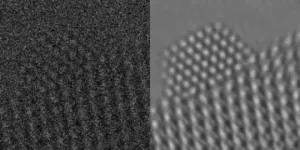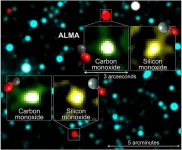(Press-News.org) A team of scientists has developed a method to illuminate the dynamic behavior of nanoparticles, which are foundational components in the creation of pharmaceuticals, electronics, and industrial and energy-conversion materials. The advance, reported in the journal Science, combines artificial intelligence with electron microscopy to render visuals of how these tiny bits of matter respond to stimuli.
“Nanoparticle-based catalytic systems have a tremendous impact on society,” explains Carlos Fernandez-Granda, director of NYU’s Center for Data Science and a professor of mathematics and data science, one of the paper’s authors. “It is estimated that 90 percent of all manufactured products involve catalytic processes somewhere in their production chain. We have developed an artificial-intelligence method that opens a new window for the exploration of atomic-level structural dynamics in materials.”
The work, which also included researchers from Arizona State University, Cornell University, and the University of Iowa, blends electron microscopy with AI to enable scientists to see the structures and movements of molecules that are one-billionth of a meter in size at an unprecedented time resolution.
“Electron microscopy can capture images at a high spatial resolution, but because of the velocity at which the atomic structure of nanoparticles changes during chemical reactions, we need to gather data at a very high speed to understand their functionality,” explains Peter A. Crozier, a professor of materials science and engineering at Arizona State University and one of the paper’s authors. “This results in extremely noisy measurements. We have developed an artificial-intelligence method that learns how to remove this noise—automatically—enabling the visualization of key atomic-level dynamics.”
Observing the movement of atoms on a nanoparticle is crucial to understand functionality in industrial applications. The problem is that the atoms are barely visible in the data, so scientists cannot be sure how they are behaving—the equivalent of tracking objects in a video taken at night with an old camera. To address this challenge, the paper’s authors trained a deep neural network, AI’s computational engine, that is able to “light up” the electron-microscope images, revealing the underlying atoms and their dynamic behavior.
“The nature of changes in the particle is exceptionally diverse, including fluxional periods, manifesting as rapid changes in atomic structure, particle shape, and orientation; understanding these dynamics requires new statistical tools,” explains David S. Matteson, a professor and associate chair of Cornell University’s Department of Statistics and Data Science, director of the National Institute of Statistical Sciences, and one of the paper’s authors. “This study introduces a new statistic that utilizes topological data analysis to both quantify fluxionality and to track the stability of particles as they transition between ordered and disordered states.”
The research was supported by grants from the National Science Foundation (OAC-1940263, OAC-2104105, CBET 1604971, DMR 184084, CHE 2109202, OAC-1940097, OAC-2103936, OAC-1940124, DMS-2114143).
DOI: 10.1126/science.ads2688
# # #
END
Scientists use AI to better understand nanoparticles
Breakthrough enables visualization of how the building blocks of pharmaceuticals, electronics, and industrial materials behave
2025-03-03
ELSE PRESS RELEASES FROM THIS DATE:
We feed gut microbes sugar, they make a compound we need
2025-03-03
Gut microbes that were thought to feed exclusively on dietary fiber also get fed sugar from our guts, from which they produce short-chain fatty acids that are crucial to many body functions. The Kobe University discovery of this symbiotic relationship also points the way to developing novel therapeutics.
Gut microbes produce many substances that our body needs but cannot produce itself. Among them are short-chain fatty acids that are the primary energy source for the cells lining our guts but have other important roles, too, and ...
One of the largest psychotherapy trials in the world has implications for transforming mental health care during pregnancy and after birth
2025-03-03
Approximately one in five of pregnant and postpartum individuals experience depression and anxiety, yet less than 10 per cent receive proper treatment.
To address this problem, a team of interdisciplinary researchers from Canada and the United States investigated if talk therapy can be effectively delivered by non-mental health specialists and telemedicine to increase access. In a paper published today in Nature Medicine, they share results from the Scaling Up Maternal Mental health care by Increasing access to Treatment (SUMMIT) Trial, which reveals promising strategies to provide the necessary support and treatment more effectively and inclusively ...
It’s not just what you say – it’s also how you say it
2025-03-03
EVANSTON, Ill. --- You’ve probably heard the phrase, “It’s not what you say, it’s how you say it,” and now, science backs it up. A first-of-its-kind study from Northwestern University’s School of Communication, the University of Pittsburgh and the University of Wisconsin-Madison reveals a region of the brain, long known for early auditory processing, plays a far greater role in interpreting speech than previously understood.
The multidisciplinary study being published Monday, March ...
Sleep patterns may reveal comatose patients with hidden consciousness
2025-03-03
NEW YORK, NY (March 3, 2025)--Several studies in the past decade have revealed that up to a quarter of unresponsive patients with recent brain injuries may possess a degree of consciousness that’s normally hidden from their families and physicians.
New research from Columbia University and NewYork-Presbyterian may soon help physicians identify unresponsive brain-injury patients with hidden consciousness who are likely to achieve long-term recovery by looking for brain waves that are indicative of normal sleep patterns.
“We’re at an exciting crossroad in neurocritical care where we know that many patients appear to be unconscious, but some are recovering without ...
3D genome structure guides sperm development
2025-03-03
Two new landmark studies show how a seeming tangle of DNA is actually organized into a structure that coordinates thousands of genes to form a sperm cell. The work, published March 3 as two papers in Nature Structural and Molecular Biology, could improve treatment for fertility problems and developmental disorders.
“We are finding the 3D structure of the genome,” said Satoshi Namekawa, professor of microbiology and molecular genetics at the University of California, Davis and senior author on one of the papers. “This is really showing us how the genomic architecture guides development.”
Although DNA is a long, stringy molecule, in living ...
Certain genetic alterations may contribute to the primary resistance of colorectal and pancreatic cancers to KRAS G12C inhibitors
2025-03-03
Bottom Line: Colorectal cancer and pancreatic ductal adenocarcinoma that harbored the KRAS G12C mutation often carried other genetic alterations that can be associated with resistance to KRAS G12C inhibitors, despite no prior treatment with this therapy, according to recent results from a large multidatabase analysis.
Journal in Which the Study was Published: Clinical Cancer Research, a journal of the American Association for Cancer Research (AACR)
Author: Hao Xie, MD, PhD, a medical oncologist at Mayo Clinic Comprehensive Cancer Center
Background: “The KRAS pathway plays a crucial role in cell biology by regulating ...
Melting Antarctic ice sheets will slow Earth’s strongest ocean current
2025-03-03
Melting ice sheets are slowing the Antarctic Circumpolar Current (ACC), the world’s strongest ocean current, researchers have found.
This melting has implications for global climate indicators, including sea level rise, ocean warming and viability of marine ecosystems.
The researchers, from the University of Melbourne and NORCE Norway Research Centre, have shown the current slowing by around 20 per cent by 2050 in a high carbon emissions scenario.
This influx of fresh water into the Southern Ocean is expected to change ...
Hallucinogen use linked to 2.6-fold increase in risk of death for people needing emergency care
2025-03-03
People seeking emergency care for hallucinogen use were at 2.6-fold higher risk of death within 5 years than the general population, according to a new study published in CMAJ (Canadian Medical Association Journal) https://www.cmaj.ca/lookup/doi/10.1503/cmaj.241191.
The use of hallucinogens, such as ketamine, psychedelics, psilocybin, LSD, ayahuasca, and MDMA (Ecstasy), has rapidly increased since the mid-2010s, especially in Canada and the United States. In the US, the percentage of people reporting they used hallucinogens more than doubled from 3.8% in 2016 to 8.9% in 2021. “In Canada, an estimated 5.9% of people used a psychedelic ...
Pathogenicity threshold of SCA6 causative gene CACNA1A was identified
2025-03-03
Niigata, Japan - The Department of Neurology at Niigata University and National Center of Neurology and Psychiatry(NCNP) has identified pathogenic thresholds for the CAG repeat units (RU) of the CACNA1A gene that causes SCA6. They investigated the SCA6 causative gene in 2,768 patients. They carefully examined the relationship between RU, age of onset, and family history. First, in cases with 18 or fewer RU, the proportion of family history was low. For 19 or more RU, the proportion of family history ...
Mysterious interstellar icy objects
2025-03-03
Niigata, Japan - Organic molecules that serve as the building blocks of life are believed to form in space, but their exact formation sites and delivery mechanisms to planets remain a major mystery in astronomy and planetary science. One of the key elements in solving this mystery is the presence of ice in interstellar environments. In cold, dense, and shielded regions of the galaxy, atoms and molecules adhere to the surfaces of submicron-sized solid particles (dust), leading to the formation of interstellar ices. This process is similar to how snow forms in Earth’s clouds.
Astronomers from Niigata University and ...
LAST 30 PRESS RELEASES:
New expert guidance urges caution before surgery for patients with treatment-resistant constipation
Solar hydrogen can now be produced efficiently without the scarce metal platinum
Sleeping in on weekends may help boost teens’ mental health
Study: Teens use cellphones for an hour a day at school
After more than two years of war, Palestinian children are hungry, denied education and “like the living dead”
The untold story of life with Prader-Willi syndrome - according to the siblings who live it
How the parasite that ‘gave up sex’ found more hosts – and why its victory won’t last
When is it time to jump? The boiling frog problem of AI use in physics education
Twitter data reveals partisan divide in understanding why pollen season's getting worse
AI is quick but risky for updating old software
Revolutionizing biosecurity: new multi-omics framework to transform invasive species management
From ancient herb to modern medicine: new review unveils the multi-targeted healing potential of Borago officinalis
Building a global scientific community: Biological Diversity Journal announces dual recruitment of Editorial Board and Youth Editorial Board members
Microbes that break down antibiotics help protect ecosystems under drug pollution
Smart biochar that remembers pollutants offers a new way to clean water and recycle biomass
Rice genes matter more than domestication in shaping plant microbiomes
Ticking time bomb: Some farmers report as many as 70 tick encounters over a 6-month period
Turning garden and crop waste into plastics
Scientists discover ‘platypus galaxies’ in the early universe
Seeing thyroid cancer in a new light: when AI meets label-free imaging in the operating room
Neutrophil-to-lymphocyte ratio may aid risk stratification in depressive disorder
2026 Seismological Society of America Annual Meeting
AI-powered ECG analysis offers promising path for early detection of chronic obstructive pulmonary disease, says Mount Sinai researchers
GIMM uncovers flaws in lab-grown heart cells and paves the way for improved treatments
Cracking the evolutionary code of sleep
Medications could help the aging brain cope with surgery, memory impairment
Back pain linked to worse sleep years later in men over 65, according to study
CDC urges ‘shared decision-making’ on some childhood vaccines; many unclear about what that means
New research finds that an ‘equal treatment’ approach to economic opportunity advertising can backfire
Researchers create shape-shifting, self-navigating microparticles
[Press-News.org] Scientists use AI to better understand nanoparticlesBreakthrough enables visualization of how the building blocks of pharmaceuticals, electronics, and industrial materials behave




